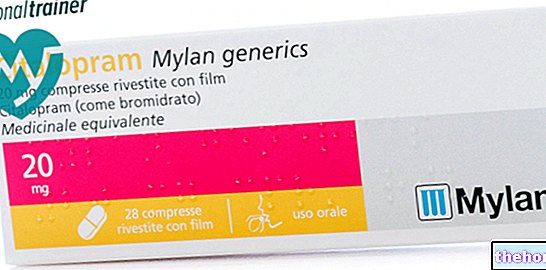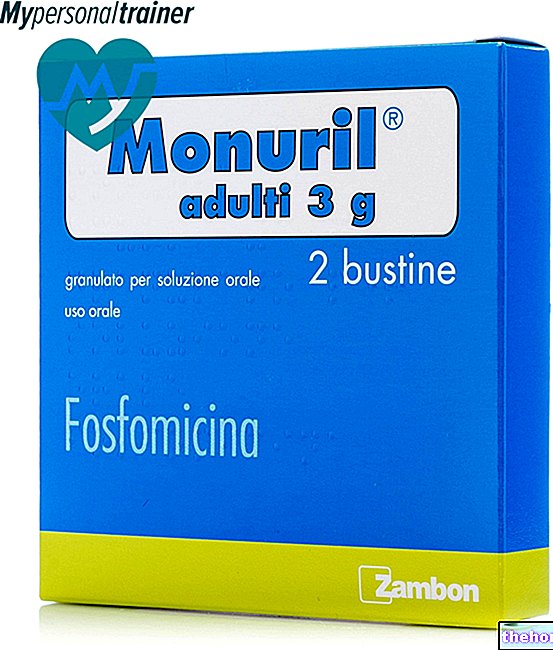Active ingredients: Colistin (Sodium colistimethate)
Colimycin 1,000,000 IU / 4ml powder and solvent for solution for injection or infusion
Why is Colimycin used? What is it for?
Colimycin contains sodium colistimethate.
Colimycin is given by injection to treat some types of serious infections caused by certain bacteria. Colimycin is used when other antibiotics are not suitable.
Contraindications When Colimycin should not be used
Do not use Colimycin
- if you are allergic (hypersensitive) to sodium colistimethate, colistin or other polymyxins;
- if you are pregnant (see section "Pregnancy and breast-feeding");
- if you are breast-feeding (see section "Pregnancy and breast-feeding");
Precautions for use What you need to know before taking Colimycin
Talk to your doctor, pharmacist or nurse before using Colimycin:
- if you have or have ever had kidney problems;
- if you suffer from myasthenia gravis
- if you suffer from porphyria;
In premature babies and newborns, special care should be taken when using Colimycin, because the kidneys are not yet fully developed.
Interactions Which drugs or foods can modify the effect of Colimycin
Tell your doctor or pharmacist if you are taking, have recently taken or might take any other medicines.
It is especially important that you talk to your doctor if you are:
- medicines that can affect kidney function. If you take this type of medicine at the same time as Colimycin, the risk of kidney damage may increase.
- medicines that can affect the nervous system. If you take this type of medicine at the same time as Colimycin, the risk of side effects affecting the nervous system may be increased.
- medicines called muscle relaxants, often used during general anesthesia. Colimycin may enhance the effects of these medicines. If you are given a general anesthetic, please tell your anesthetist about your use of Colimycin.
If you have myasthenia gravis and are also taking other antibiotics called macrolides (such as azithromycin, clarithromycin or erythromycin) or antibiotics called fluoroquinolones (such as ofloxacin, norfloxacin and ciprofloxacin), taking Colimycin further increases the risk of muscle weakness and breathing difficulties.
If you receive sodium colistimethate at the same time by infusion and inhalation, the risk of side effects may increase.
Warnings It is important to know that:
Pregnancy and breastfeeding
If you are pregnant or breast-feeding, think you may be pregnant or are planning to have a baby, ask your doctor for advice before using this medicine.
Colimycin must not be used during pregnancy or if you are breast-feeding (see section "Do not use Colimycin").
Driving and using machines
During treatment with Colimycin, nervous system disorders such as tingling around the mouth, tingling of the extremities, itching and dizziness may occur. If this happens, do not drive or use any tools or machines.
Dose, Method and Time of Administration How to use Colimycin: Posology
Colimycin is given by your doctor as an infusion into a vein lasting 30 to 60 minutes.
In the treatment of bacterial infections it is important to complete the entire course of treatment. Your doctor will decide how and for how long to give you Colimycin.
The usual daily dose for adults is 9 million units, divided into two or three doses. If you are quite ill, you will be given a dose greater than 9 million units once at the start of treatment.
In some cases, your doctor may decide to give you a higher daily dose, up to a maximum of 12 million units.
The usual daily dose for children weighing up to 40 kg is 75,000-150,000 units per kilogram of body weight, divided into three doses.
Higher doses have occasionally been given in cystic fibrosis.
Children and adults with kidney problems, even on dialysis, usually receive lower doses. Your doctor will check your kidney function regularly while you are receiving Colimycin.
Overdose What to do if you have taken an overdose of Colimycin
If you use more Colimycin than you should
As Colimycin will be given to you by a doctor, it is unlikely that you will be given an incorrect dose. If you have any questions about the amount of this medicine that you should be given, ask your doctor or nurse. Symptoms of taking too much colimycin include:
- lethargy (sleepiness);
- confusion (mental disorder);
- psychosis (severe alteration of the psychic balance);
- dizziness (feeling of unsteadiness);
- ataxia (inability to stand upright);
- facial paraesthesia (altered sensitivity in the face);
- nystagmus (rapid, uncontrolled movements of the eyes);
- difficulty in speaking;
- severe kidney disorders such as sharp decrease in urine volume and increased nitrogen and creatinine in the blood;
- muscle weakness;
- apnea (difficulty in breathing).
If you forget to use Colimycin
If you think you have missed a dose of Colimycin, please tell your doctor or pharmacist or nurse.
If you stop taking Colimycin
Your doctor will decide how long Colimycin will be given to you. It is important that you complete your treatment as recommended by your doctor, otherwise your symptoms may get worse.
If you have any further questions on the use of this medicine, ask your doctor, pharmacist or nurse.
Side Effects What are the side effects of Colimycin
Like all medicines, this medicine can cause side effects, although not everybody gets them.
Some side effects can be serious
Tell your doctor or nurse immediately if you notice any of the following symptoms:
- wheezing or difficulty breathing which could lead to collapse, rash, itching or hives on the skin. These can be signs of a severe allergic reaction;
- diarrhea. It can be a symptom of a severe bowel infection.
The following side effects have also been reported:
- Injection site reaction;
- Kidney problems such as kidney failure, renal toxicity, increased nitrogen and creatinine in the blood, decreased urine volume. These effects are more likely in patients who already have impaired kidney function or who are given Colimycin at the same time as other medicines that affect the kidneys, or are given too high a dose.These problems usually improve when treatment is stopped or the dose of Colimycin is reduced.
- Neurological problems such as inability to breathe due to paralysis of the chest muscles, numbness or tingling (especially around the face), dizziness or loss of balance, changes in blood pressure or blood flow (which include weakness and flushing heat), difficulty speaking. Side effects affecting the nervous system are more likely to occur when the dose of Colimycin is too high, in people who have impaired kidney function, or in those who are also receiving muscle relaxation drugs or other medicines that have a similar effect by acting on the nervous system.
- Confusion and mental problems (including loss of sense of reality)
- Visual problems
- Vertigo
- Fever.
- Gastrointestinal disorders: diarrhea.
Reporting of side effects
If you get any side effects, talk to your doctor or pharmacist or nurse. This includes any possible side effects not listed in this leaflet. You can also report side effects directly. : https://www.aifa.gov.it/content/segnalazioni-reazioni-avverse
By reporting side effects you can help provide more information on the safety of this medicine.
Expiry and Retention
Keep this medicine out of the sight and reach of children.
Do not use this medicine after the expiry date which is stated on the carton and bottle after: EXP. The expiry date refers to the last day of that month.
Do not store above 25 ° C.
The powder contained in the vial must be dissolved only at the time of use with the physiological solution contained in the vial provided inside the package.
During this operation it is possible to perceive variations in the pressure to be exerted on the plunger of the syringe to introduce the solvent into the vial with the powder. These differences, which can be seen between different packs of Colimycin, are not in themselves an indication of a defect in the quality of the medicine.
Each reconstituted vial of Colimycin solution for injection or infusion is for single use only. Any remaining unused solution must be thrown away (single use).
After reconstitution, Colimycin should be used immediately.
The reconstituted solution should only be used if it is clear and free of particles.
Do not throw any medicines via wastewater or household waste. Ask your pharmacist how to throw away medicines you no longer use. This will help protect the environment.
What Colimycin contains
- The active ingredient is sodium colistimethate
- The other ingredients contained in the solvent ampoule are sodium chloride and water for injections.
Description of what Colimycin looks like and contents of the pack
In each pack of Colimycin there are a vial, containing the active ingredient in powder, and a vial, containing the solvent (physiological sodium chloride solution and water for injections).
Colimycin powder is white. The solvent is a clear and colorless solution.
Source Package Leaflet: AIFA (Italian Medicines Agency). Content published in January 2016. The information present may not be up-to-date.
To have access to the most up-to-date version, it is advisable to access the AIFA (Italian Medicines Agency) website. Disclaimer and useful information.
01.0 NAME OF THE MEDICINAL PRODUCT
COLIMYCINE 1,000,000 IU / 4 ML POWDER AND SOLVENT FOR SOLUTION FOR INJECTION OR FOR INFUSION
02.0 QUALITATIVE AND QUANTITATIVE COMPOSITION
Each vial contains: sodium colistimethate 1,000,000 IU.
For the full list of excipients, see section 6.1.
03.0 PHARMACEUTICAL FORM
Powder and solvent for solution for injection or infusion.
04.0 CLINICAL INFORMATION
04.1 Therapeutic indications
Colimycin is indicated in adults and children, including neonates, for the treatment of serious infections due to certain Gram-negative pathogens in patients for whom treatment options are limited (see sections 4.2, 4.4, 4.8 and 5.1).
Pay attention to the official guidelines for the correct use of antibacterial agents.
04.2 Posology and method of administration
The dose to be administered and the duration of treatment should be established taking into account the severity of the infection and the clinical response. Therapeutic guidelines should be followed.
The dose is expressed in international units (IU) of sodium colistimethate (CMS). At the end of the paragraph there is a conversion table from IU to mg of CMS and to mg of base activity of colistin (colistin base activity, CBA).
Dosage
The following dosing recommendations are based on limited population pharmacokinetic data in critically ill patients (see section 4.4):
Adults and adolescents
Maintenance dose: 9 MIU / day divided into 2-3 doses.
In critically ill patients a loading dose of 9 MIU should be administered.
The most suitable interval to the first maintenance dose has not been established.
Models suggest that loading and maintenance doses of up to 12 MIU may be required in patients with good renal function in some cases. However, clinical experience with these doses is extremely limited and safety has not been established.
The loading dose is valid for patients with normal or reduced renal function, including those undergoing renal replacement therapy.
Renal impairment
The dose should be adjusted in the presence of renal impairment, but the pharmacokinetic data available for patients with impaired renal function are very limited.
The following dose modifications are provided for guidance.
A dose reduction is recommended in patients with creatinine clearance
two daily administrations are recommended.
MUI = million IU
Hemodialysis and continuous hemo (dia) filtration
Colistin appears dialyzable by conventional methods of hemodialysis and continuous veno-venous hemo (dia) filtration (continuous venovenous haemo (dia) filtration, CVVHF, CVVHDF). Extremely limited data are available from population pharmacokinetic studies in very small numbers of patients undergoing renal replacement therapy. No definitive dosage recommendations can be made. The following therapeutic regimens can be considered.
Hemodialysis
Days without hemodialysis: 2.25 MIU / day (2.2-2.3 MIU / day).
Hemodialysis days: 3 MIU / day on hemodialysis days, to be administered after the hemodialysis session.
Two daily administrations are recommended.
CVVHF / CVVHDF
As in patients with normal renal function. Three daily administrations are recommended.
Hepatic impairment
No data are available in patients with hepatic impairment. Caution is advised when administering sodium colistimethate to these patients.
Senior citizens
No dose adjustments are considered necessary in elderly patients with normal renal function.
Pediatric population
Data to support the dosing regimen in pediatric patients are very limited. Renal maturity should be taken into account for the determination of the dose. The dose should be based on the weight of the lean body mass.
Children ≤40 kg
75,000-150,000 IU / kg / day divided into 3 doses.
For children weighing more than 40 kg the dosage recommendations valid for adults should be considered.
The use of doses> 150,000 IU / kg / day in children with cystic fibrosis has been reported.
No data are available on the use or extent of loading doses in critically ill children.
No dosage recommendations have been made in children with impaired renal function.
Intrathecal and intraventricular administration
Based on limited data the following dose is recommended for adults:
Intraventricular route
125,000 IU / day
Doses administered intrathecally should not exceed those recommended for intraventricular use.
No specific dosage recommendations can be made for the intrathecal and intraventricular routes of administration in children.
Method of administration
Administer colimycin intravenously by slow infusion lasting 30-60 minutes.
In aqueous solution, sodium colistimethate is hydrolyzed to the active ingredient colistin. For preparation of the dose, particularly when composed of the contents of several vials, the required dose must be reconstituted under conditions of absolute asepsis (see section 6.6).
Conversion table
In the EU, the dose of sodium colistimethate (CMS) should only be prescribed and administered in international units (IU). The label shows the number of IU per vial.
In the past, confusion and administration errors have occurred due to the use of different dose units in terms of potency. In the US and other parts of the world, the dose is expressed in milligrams of base colistin activity (milligrams of colistin base activity, mg CBA).
The following conversion table is given as a guide and the values are to be considered nominal and approximate only.
Conversion table for CMS
* Nominal potency of the drug substance = 12,500 IU / mg
04.3 Contraindications
Hypersensitivity to colistin and to other antibiotics of the polymyxin family or to one of the excipients listed in section 6.1.
Pregnancy and lactation (see section 4.6).
04.4 Special warnings and appropriate precautions for use
Whenever possible, co-administration of intravenous sodium colistimethate with another antibacterial agent should be considered, taking into account the remaining sensitivity of the pathogen or pathogens being treated. As the development of resistance to intravenous colistin has been reported, particularly when used alone, co-administration with other antibacterials should also be considered to prevent the development of resistance.
Only limited clinical data on the efficacy and safety of intravenously administered sodium colistimethate are available. The recommended doses in all subpopulations are also based on limited data (clinical and pharmacokinetic / pharmacodynamic). In particular, safety data are available. limited for the use of high doses (> 6 MIU / day), for the use of a loading dose and for special populations (patients with renal impairment and pediatric population). Sodium colistimethate should only be used when other antibiotics most commonly prescribed are ineffective or unsuitable.
Monitoring of renal function should be performed in all patients at the initiation of treatment and at regular intervals during treatment. The dose of sodium colistimethate should be adjusted according to creatinine clearance (see section 4.2). Hypovolaemic and hypovolaemic patients receiving other potentially nephrotoxic drugs have an increased risk of nephrotoxicity due to colistin (see sections 4.5 and 4.8). In some studies, nephrotoxicity was associated with cumulative dose and duration of treatment. The benefit of prolonged treatment should be weighed. in relation to the potential increased risk of renal toxicity.
Caution is advised when sodium colistimethate is administered to infants less than 1 year of age, as renal function has not reached full maturity in this age group. Furthermore, the effect of immature renal and metabolic function is not known. on the conversion of sodium colistimethate to colistin.
In the event of an allergic reaction, treatment with sodium colistimethate should be discontinued and appropriate measures taken.
Elevated serum concentrations of sodium colistimethate, which may be due to overdose or missed dose reduction in patients with renal impairment, have been observed to induce neurotoxic effects such as facial paraesthesia, muscle weakness, dizziness, slurred speech, vasomotor instability, visual disturbances, confusion, psychosis and apnea (see section 4.7). Respiratory assistance will be necessary until blood levels are reduced. Therapy can be resumed, if there is a life-threatening situation of the patient, at lower doses. The subjective symptoms reported by the adult may not be manifested in children. smaller, so their kidney function must be monitored.
Patients should be monitored for perioral paraesthesia and extremity paraesthesia which are signs of overdose (see section 4.9).
Sodium colistimethate is known to reduce presynaptic release of acetylcholine at the neuromuscular junction and should be used with extreme caution and only if clearly needed in patients with myasthenia gravis.
Cases of respiratory arrest have been reported following intramuscular administration of sodium colistimethate. Impaired renal function increases the likelihood of apnea and neuromuscular block following administration of sodium colistimethate.
Sodium colistimethate should be used with extreme caution in patients with porphyria.
Antibiotic-associated colitis and pseudomembranous colitis have been reported with almost all antibacterials and can also occur with sodium colistimethate. Their severity can range from mild to life-threatening. It is important to consider this diagnosis in patients who develop diarrhea during or after use of colistimethate sodium (see section 4.8). Discontinuation of therapy and initiation of specific treatment should be considered. Clostridium difficile. Medicinal products that inhibit peristalsis should not be given.
Intravenously administered sodium colistimethate does not cross the blood brain barrier to a clinically relevant extent. Intrathecal or intraventricular administration of sodium colistimethate in the treatment of meningitis has not been systematically evaluated in clinical studies and is supported only by individual case reports. The data to support the posology are very limited. The most commonly observed adverse effect following administration of CMS was aseptic meningitis (see section 4.8).
During systemic treatment, it is recommended that plasma concentrations be monitored in neonates, patients with renal insufficiency and those with cystic fibrosis.
04.5 Interactions with other medicinal products and other forms of interaction
In case of concomitant use of intravenous sodium colistimethate with other potentially nephrotoxic or neurotoxic medicinal products (e.g. the following antibiotics: kanamycin, neomycin, streptomycin, gentamicin, tobramycin) extreme caution should be exercised.
Certain antibiotics, such as aminoglycosides and other polymyxins, have been reported to interfere with nerve transmission at the neuromuscular junction.
Aminoglycosides and polymyxins cannot be administered together with colimycin parenterally unless under strict medical supervision.
Caution should be exercised in case of concomitant use with other pharmaceutical forms of sodium colistimethate, as experience is limited and there is a risk of cumulative toxicity.
No interaction studies have been performed in vivo. The mechanism of conversion of sodium colistimethate to the active ingredient colistin is not characterized. The mechanism of colistin clearance, including renal processes, is also unknown. Neither sodium colistimethate nor colistin induced the activity of any of the P450 (CYP) enzymes tested (CYP1A2, 2B6, 2C8, 2C9, 2C19 and 3A4 / 5) in studies in vitro on human hepatocytes.
Potential drug interactions should be kept in mind when co-administering Colimycin with medicinal products known to inhibit or induce enzymes responsible for drug metabolism or which are substrates of renal transport mechanisms.
Due to the effects of colistin on acetylcholine release, non-depolarising muscle relaxants should be used with caution in patients receiving sodium colistimethate, as their effects may be prolonged (see section 4.4).
Concomitant treatment with sodium colistimethate and macrolides such as azithromycin and clarithromycin or fluoroquinolones such as norfloxacin and ciprofloxacin should be performed with caution in patients with myasthenia gravis (see section 4.4).
04.6 Pregnancy and lactation
The use of the drug is contraindicated in case of pregnancy and during lactation (see section 4.3).
In the second and third trimester of pregnancy there is a risk of possible fetal toxicity. Colistin is present in milk but is poorly absorbed from the intestine.
04.7 Effects on ability to drive and use machines
Neurological disorders may occur during therapy (see section 4.4). Patients should be advised not to drive or use machines if these effects occur.
04.8 Undesirable effects
The following adverse reactions have been reported:
Disorders of the immune system: hypersensitivity reactions such as rash and angioedema.
Psychiatric disorders: confusion, psychosis.
Nervous system disorders: neurotoxic effects, paraesthesia, dizziness, tingling in the extremities and tongue, rarely speech disturbance and autonomic nervous system imbalance. Neuromuscular block in case of overdose or combination with curative agents or in case of insufficient renal elimination.
Eye disorders: visual disturbances.
Ear and labyrinth disorders: vertigo.
Respiratory, thoracic and mediastinal disorders: respiratory distress up to insufficiency, apnea.
Gastrointestinal disorders: diarrhea (see section 4.4).
Skin and subcutaneous tissue disorders: generalized itching, hives, rash.
Renal and urinary disorders: renal failure, renal impairment demonstrated by increased creatinine and / or urea in the blood and / or decreased renal clearance of creatinine.
General disorders and administration site conditions: fever, injection site reaction.
Diagnostic tests: decreased urine output, decreased creatinine clearance.
Reporting of suspected adverse reactions
Reporting of suspected adverse reactions occurring after authorization of the medicinal product is important as it allows continuous monitoring of the benefit / risk balance of the medicinal product. Healthcare professionals are asked to report any suspected adverse reactions via the national reporting system. "Italian Medicines Agency, website: www.agenziafarmaco.gov.it/it/responsabili.
04.9 Overdose
Symptoms of overdose may be observed in patients with impaired renal function. Dosages higher than the maximum ones can cause acute renal failure manifested by oliguria, azotemia, hypercreatininemia, usually reversible by discontinuing treatment.
Elevated serum concentrations of colistimethate sodium, which may be due to overdose or missed dose reduction in patients with renal impairment, have been shown to induce neurotoxic effects such as lethargy, ataxia, facial paraesthesia, muscle weakness, dizziness, speech difficulty , vasomotor instability, visual disturbances, confusion, psychosis.
Apnea can also occur as a result of which respiratory arrest and death can occur.
Patients should be monitored for perioral paraesthesia and extremity paraesthesia which are signs of overdose (see section 4.4). In the event of an overdose, treatment with sodium colistimethate should be discontinued and appropriate supportive measures should be employed.
Colistin is not eliminated by hemodialysis.
It is not known whether sodium colistimethate can be removed by hemodialysis or peritoneal dialysis in cases of overdose.
05.0 PHARMACOLOGICAL PROPERTIES
05.1 Pharmacodynamic properties
Pharmacotherapeutic group: antibacterials for systemic use, other antibacterials, polymyxins.
ATC code: J01XB01.
Mechanism of action
Colistin is a cyclic polypeptide antibacterial belonging to the group of polymyxins. The action of polymyxins is based on damage to the cell membrane and the consequent physiological effects are lethal for bacteria. Polymyxins are selective for aerobic Gram-negative bacteria with a hydrophobic outer membrane.
Resistence
Resistant bacteria are distinguished by modifications to the phosphate groups of the lipopolysaccharide which are replaced with ethanolamine or amino-arabinose. Naturally resistant Gram-negative bacteria, such as Proteus mirabilis And Burkholderia cepacia, show a complete substitution of the lipid phosphate with ethanolamine or amino-arabinose.
Cross-resistance is expected between colistin (polymyxin E) and polymyxin B. Since the mechanism of action of polymyxin is different from that of other antibacterials, resistance to colistin and polymyxin due to the mechanism described above alone should not induce resistance against of other classes of drugs.
Pharmacokinetic / pharmacodynamic correlation
Polymyxins have been observed to exhibit a concentration-dependent bactericidal effect on susceptible bacteria. FAUC / MIC is believed to be related to clinical efficacy.
EUCAST limit concentrations
to The limiting concentrations are valid for a dosage of 2-3 MIU x 3. Loading dose (9 MIU) may be needed.
Sensitivity
The prevalence of acquired resistance may vary geographically and over time for certain species and local information on resistance is advisable, particularly for the treatment of severe infections. As necessary, expert advice should be sought when the local prevalence of resistance is such that the utility of the medicinal product, at least in some types of infections, is questionable.
05.2 "Pharmacokinetic properties
There is limited information on the pharmacokinetics of sodium colistimethate (CMS) and colistin. Some data indicate that, in critically ill patients, the pharmacokinetics are different from that observed in patients with less severe physiological imbalances and in healthy volunteers. The following data are based on studies conducted with the HPLC method to determine plasma concentrations of CMS / colistin.
After infusion of sodium colistimethate, the inactive prodrug is converted to the active substance colistin. Peak plasma concentrations of colistin were observed with a maximum delay of 7 hours after administration of sodium colistimethate in critically ill patients.
Distribution
The volume of distribution of colistin in healthy volunteers is low and roughly corresponds to the extracellular fluid. The volume of distribution increases significantly in critically ill subjects. Protein binding is moderate and decreases at higher concentrations. In the absence of meningeal inflammation, cerebrospinal fluid penetration is minimal, but increases in the presence of meningeal inflammation.
Both CMS and colistin exhibit linear pharmacokinetics over the clinically relevant dose range.
Elimination
It is estimated that about 30% of sodium colistimethate is converted to colistin in healthy subjects; its clearance is dependent on creatinine clearance and a higher percentage of CMS is converted to colistin in case of decreased renal function. In patients with severely impaired renal function (creatinine clearance glomerular filtration. In healthy subjects, 60% -70% of CMS is excreted unchanged in the urine within 24 hours.
The elimination of the active substance colistin is only partially characterized. Colistin is extensively reabsorbed in the renal tubule and can be eliminated both non-renally and via renal metabolism, with the risk of accumulation in the kidneys. Colistin clearance is reduced in case of renal impairment, possibly due to "increased CMS conversion."
The half-life of colistin in healthy subjects and in subjects with cystic fibrosis amounts, respectively, to about 3 h and 4 h, with a total clearance of about 3 L / h. In critically ill patients the half-life is prolonged to about 9- 18 h.
05.3 Preclinical safety data
The toxic effects of Colistin may be due to sodium colistimethate and are expressed in the form of tubular damage. With 3 mg / kg there may be an increase in azotemia; with 2.5 mg / kg there may be albuminuria and haematuria. However, these phenomena are reversible after discontinuation of therapy. High and prolonged doses of sodium colistimethate in patients with pathologies kidney can cause neurotoxicity and nephrotoxicity, for which the doses must be appropriately reduced.
06.0 PHARMACEUTICAL INFORMATION
06.1 Excipients
Sodium chloride, water for injections.
06.2 Incompatibility
In the absence of incompatibility studies, this medicinal product must not be mixed with other medicinal products.
06.3 Period of validity
3 years in intact packaging.
06.4 Special precautions for storage
Do not store above 25 ° C.
06.5 Nature of the immediate packaging and contents of the package
Glass vial of 1,000,000 IU of sodium colistimethate + 1 solvent vial 4 ml.
06.6 Instructions for use and handling
Dissolve the powder contained in the vial only at the time of use with the physiological solution contained in the vial. During this operation it is possible to perceive variations in the pressure to be exerted on the plunger of the syringe to introduce the solvent into the vial with the powder. may notice between different packs of Colimycin, they are not in themselves an indication of a quality defect in the medicine.
After reconstitution, the solution should be diluted to an appropriate volume for a 30-60 minute infusion with sodium chloride 9 mg / ml (0.9%) solution for infusion.
The solution should be visually inspected for particles or discolouration prior to administration. The solution should only be used if it is clear and free of particles.
07.0 MARKETING AUTHORIZATION HOLDER
UCB Pharma S.p.A. - Via Varesina, 162 - 20156 Milan (Italy).
08.0 MARKETING AUTHORIZATION NUMBER
A.I.C. n. 011297013
09.0 DATE OF FIRST AUTHORIZATION OR RENEWAL OF THE AUTHORIZATION
Date of first authorization: 23 June 1956
Date of most recent renewal: June 2010
10.0 DATE OF REVISION OF THE TEXT
28 July 2015




























